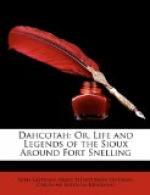INTRODUCTION.
The materials for the following pages were gathered during a residence of seven years in the immediate neighborhood—nay—in the very midst of the once powerful but now nearly extinct tribe of Sioux or Dahcotah Indians.
Fort Snelling is situated seven miles below the Falls of St. Anthony, at the confluence of the Mississippi—and St. Peter’s rivers—built in 1819, and named after the gallant Colonel Snelling, of the army, by whom the work was erected. It is constructed of stone; is one of the strongest Indian forts in the United States; and being placed on a commanding bluff, has somewhat the appearance of an old German castle, or one of the strongholds on the Rhine.
The then recent removal of the Winnebagoes was rendered troublesome by the interference of Wabashaw, the Sioux chief, whose village is on the Mississippi, 1800 miles from its mouth. The father of Wabashaw was a noted Indian; and during the past summer, the son has given some indications that he inherits the father’s talents and courage. When the Winnebagoes arrived at Wabashaw’s prairie, the chief induced them not to continue their journey of removal; offered them land to settle upon near him, and told them it was not really the wish of their Great Father, that they should remove. His bribes and eloquence induced the Winnebagoes to refuse to proceed; although there was a company of volunteer dragoons and infantry with them. This delay occasioning much expense and trouble, the government agents applied for assistance to the command at Fort Snelling. There was but one company there; and the commanding officer, with twenty men and some friendly Sioux, went down to assist the agent.
There was an Indian council held on the occasion. The Sioux who went from Fort Snelling promised to speak in favor of the removal. During the council, however, not one of them said a word—for which they afterwards gave a satisfactory reason. Wabashaw; though a young man, had such influence over his band, that his orders invariably received implicit obedience. When the council commenced, Wabashaw had placed a young warrior behind each of the friendly Sioux who he knew would speak in favor of the removal, with orders to shoot down the first one who rose for that purpose. This stratagem may be considered a characteristic specimen of the temper and habits of the Sioux chiefs, whose tribe we bring before the reader in their most conspicuous ceremonies and habits. The Winnebagoes were finally removed, but not until Wabashaw was taken prisoner and carried to Fort Snelling. Wabashaw’s pike-bearer was a fine looking warrior, named “Many Lightnings.”
The village of “Little Crow,” another able and influential Sioux chief, is situated twenty miles below the Falls of St. Anthony. He has four wives, all sisters, and the youngest of them almost a child. There are other villages of the tribe, below and above Fort Snelling.




